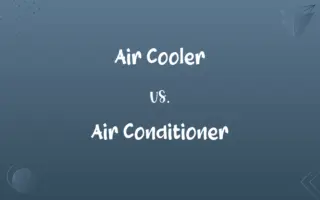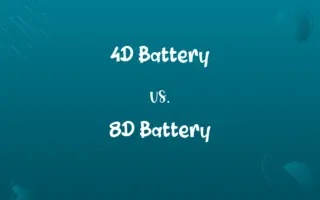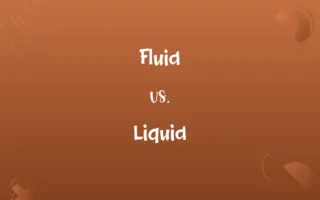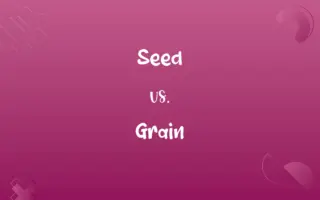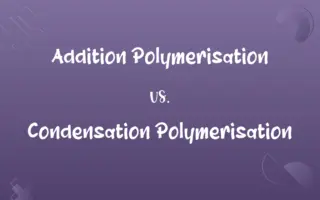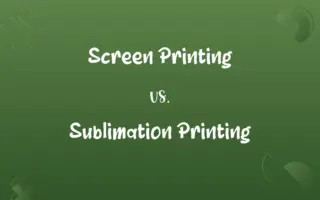Yield Strength vs. Tensile Strength: Know the Difference

By Shumaila Saeed || Updated on December 25, 2023
Yield Strength is the stress at which a material begins to deform plastically, while Tensile Strength is the maximum stress a material can withstand while being stretched or pulled.
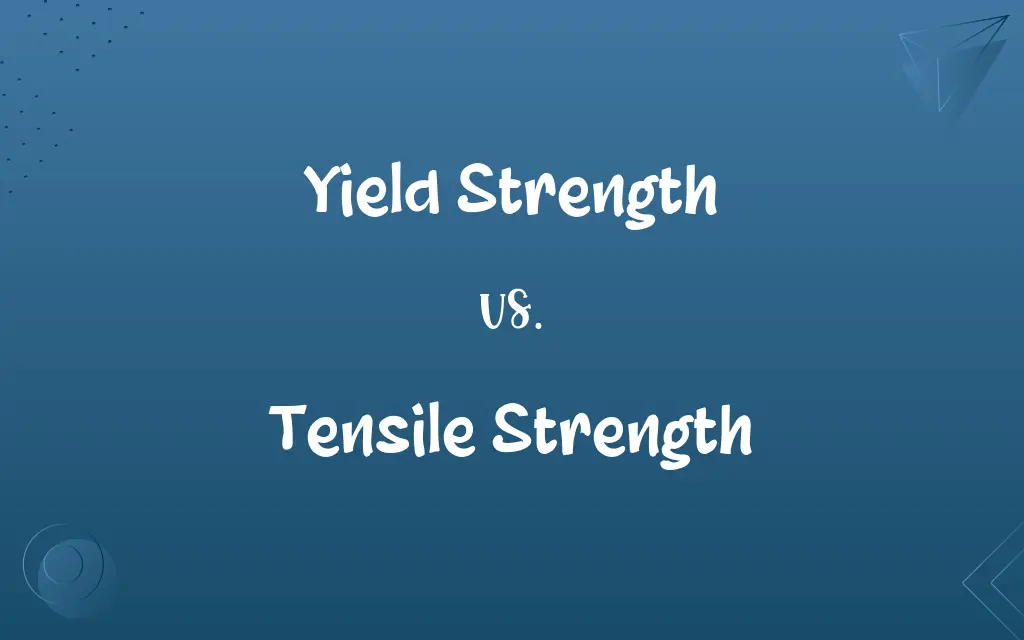
Key Differences
Yield Strength refers to the point on the stress-strain curve where a material transitions from elastic deformation to plastic deformation, indicating the limit of reversible deformation. Tensile Strength, on the other hand, represents the maximum stress that a material can bear while being stretched before breaking, showing the material's resistance to breakage under tension.
Shumaila Saeed
Dec 16, 2023
In testing, Yield Strength is identified by the stress level at which a material undergoes a permanent deformation of 0.2%, while Tensile Strength is determined at the point of fracture. Yield Strength is crucial for determining a material's ability to handle certain loads without permanently deforming, whereas Tensile Strength is essential for understanding how much stress a material can withstand before it fails.
Shumaila Saeed
Dec 16, 2023
Yield Strength is a critical property for materials that will undergo loads leading to temporary deformation, as it indicates the maximum stress that can be applied without causing permanent changes. Tensile Strength is paramount in applications where materials are subjected to stretching forces, as it measures the ultimate strength of the material when pulled.
Shumaila Saeed
Dec 16, 2023
Materials with high Yield Strength can endure higher stresses without permanent deformation, making them ideal for structural applications. Materials with high Tensile Strength can withstand greater stretching forces before breaking, which is crucial in applications like cables and ropes.
Shumaila Saeed
Dec 16, 2023
In summary, Yield Strength is about the threshold beyond which a material will not return to its original shape, while Tensile Strength concerns the extreme limit of strength a material has under tension before it ruptures.
Shumaila Saeed
Dec 16, 2023
ADVERTISEMENT
Comparison Chart
Definition
Stress at which material begins to deform plastically
Maximum stress material withstands when stretched
Shumaila Saeed
Dec 16, 2023
Testing Method
Measured at 0.2% permanent strain
Measured at point of fracture
Shumaila Saeed
Dec 16, 2023
Importance in Design
Indicates load-bearing capacity without permanent deformation
Indicates maximum load before failure
Shumaila Saeed
Dec 16, 2023
Applications
Structural components, beams, columns
Cables, ropes, structural ties
Shumaila Saeed
Dec 16, 2023
ADVERTISEMENT
Yield Strength and Tensile Strength Definitions
Yield Strength
Threshold of stress indicating the onset of plastic deformation in a material.
In safety equipment manufacturing, yield strength is a key factor to prevent irreversible damage under force.
Shumaila Saeed
Dec 09, 2023
Tensile Strength
Stress level at which a material breaks under tension.
In rock climbing equipment, tensile strength is critical to ensure safety under extreme tension.
Shumaila Saeed
Dec 09, 2023
Yield Strength
The point in stress-strain curve where elastic deformation turns to plastic.
When designing bridges, engineers consider the yield strength to prevent permanent deformations.
Shumaila Saeed
Dec 09, 2023
Tensile Strength
Maximum stress a material can bear while being pulled before it breaks.
The tensile strength of the cable determines how much weight it can suspend before snapping.
Shumaila Saeed
Dec 09, 2023
Yield Strength
The stress level at which a material ceases to return to its original shape.
Understanding the yield strength of materials is essential in creating flexible yet durable consumer products.
Shumaila Saeed
Dec 09, 2023
ADVERTISEMENT
Tensile Strength
The ultimate strength of a material subjected to tensile loading.
High tensile strength in synthetic fibers makes them suitable for heavy-duty industrial uses.
Shumaila Saeed
Dec 09, 2023
Yield Strength
The stress at which a material starts to deform permanently.
The yield strength of steel ensures it can support heavy loads in construction without warping.
Shumaila Saeed
Dec 09, 2023
Tensile Strength
The point of maximum stress in the stress-strain curve during a tensile test.
Testing the tensile strength of polymers helps in determining their suitability for flexible yet strong products.
Shumaila Saeed
Dec 09, 2023
Yield Strength
Maximum stress a material can withstand without permanent deformation.
The yield strength of aluminum alloys is crucial for aircraft design to ensure they retain their shape under stress.
Shumaila Saeed
Dec 09, 2023
Tensile Strength
Maximum amount of tensile stress a material can withstand without failure.
The tensile strength of steel beams defines their ability to withstand stretching forces in construction.
Shumaila Saeed
Dec 09, 2023
Repeatedly Asked Queries
How is Yield Strength measured?
By determining the stress at which a material permanently deforms (usually at 0.2% strain).
Shumaila Saeed
Dec 16, 2023
Why is Yield Strength important?
It indicates the maximum load a material can bear without permanent deformation, crucial for structural integrity.
Shumaila Saeed
Dec 16, 2023
How is Tensile Strength measured?
By finding the maximum stress a material can handle in a tensile test before it fractures.
Shumaila Saeed
Dec 16, 2023
Can Yield Strength be higher than Tensile Strength?
No, Tensile Strength is always higher as it is the point of material failure.
Shumaila Saeed
Dec 16, 2023
In which applications is Tensile Strength critical?
In applications where materials are stretched or pulled, like cables and ropes.
Shumaila Saeed
Dec 16, 2023
What is Yield Strength?
The stress level at which a material begins to deform plastically.
Shumaila Saeed
Dec 16, 2023
Do temperature changes affect Tensile Strength?
Yes, temperature can influence tensile strength, often reducing it at higher temperatures.
Shumaila Saeed
Dec 16, 2023
What is Tensile Strength?
The maximum stress a material can withstand under tension before breaking.
Shumaila Saeed
Dec 16, 2023
Is Yield Strength a fixed property of a material?
It varies depending on the material composition and treatment.
Shumaila Saeed
Dec 16, 2023
In which applications is Yield Strength critical?
In applications like construction and manufacturing, where materials must maintain shape under stress.
Shumaila Saeed
Dec 16, 2023
Why is Tensile Strength important?
It shows how much stretching a material can endure before failing, important for materials under tension.
Shumaila Saeed
Dec 16, 2023
Is Tensile Strength the same for all materials?
No, it varies widely based on material type and quality.
Shumaila Saeed
Dec 16, 2023
Are Yield Strength and Tensile Strength related to material hardness?
Yes, both properties are often correlated with material hardness but are distinct measurements.
Shumaila Saeed
Dec 16, 2023
Can a material's Yield Strength be increased?
Yes, through processes like heat treatment and alloying.
Shumaila Saeed
Dec 16, 2023
Can Tensile Strength be altered?
Yes, through material processing and heat treatment.
Shumaila Saeed
Dec 16, 2023
Do all materials have a Yield Strength?
Most materials have a yield point, but some, like glass and ceramics, may not exhibit clear yielding.
Shumaila Saeed
Dec 16, 2023
Is Tensile Strength important for brittle materials?
Yes, as it indicates the maximum stress brittle materials can endure before fracturing.
Shumaila Saeed
Dec 16, 2023
Do all materials have a Tensile Strength?
Yes, all materials have a tensile strength, which is the maximum stress they can withstand in tension.
Shumaila Saeed
Dec 16, 2023
How do temperature changes affect Yield Strength?
Temperature can significantly affect the yield strength, usually decreasing it with rising temperature.
Shumaila Saeed
Dec 16, 2023
Is Yield Strength relevant for ductile materials?
Yes, it's particularly important for ductile materials to determine their elastic limit.
Shumaila Saeed
Dec 16, 2023
Share this page
Link for your blog / website
HTML
Link to share via messenger
About Author
Written by
Shumaila SaeedShumaila Saeed, an expert content creator with 6 years of experience, specializes in distilling complex topics into easily digestible comparisons, shining a light on the nuances that both inform and educate readers with clarity and accuracy.
